

Electromagnetic field. The field can be viewed as the combination of an electric field and a magnetic field.
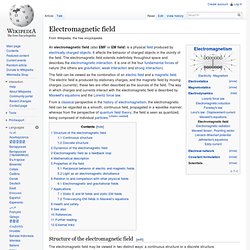
The electric field is produced by stationary charges, and the magnetic field by moving charges (currents); these two are often described as the sources of the field. Magnetostriction. Animation of magnetostriction Magnetostriction (cf. electrostriction) is a property of ferromagnetic materials that causes them to change their shape or dimensions during the process of magnetization.
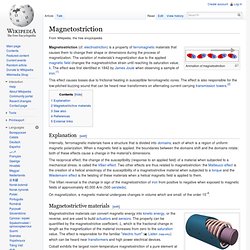
The variation of materials's magnetization due to the applied magnetic field changes the magnetostrictive strain until reaching its saturation value, λ. The effect was first identified in 1842 by James Joule when observing a sample of iron.[1] This effect causes losses due to frictional heating in susceptible ferromagnetic cores. The effect is also responsible for the low-pitched buzzing sound that can be heard near transformers on alternating current carrying transmission towers.[2] Explanation[edit] Internally, ferromagnetic materials have a structure that is divided into domains, each of which is a region of uniform magnetic polarization.
On magnetization, a magnetic material undergoes changes in volume which are small: of the order 10−6. Magnetostrictive materials[edit] See also[edit] Inverse magnetostrictive effect. The inverse magnetostrictive effect (also known as Villari effect) is the name given to the change of the magnetic susceptibility of a material when subjected to a mechanical stress.

Explanation[edit] Whereas magnetostriction characterizes the shape change of a ferromagnetic material during magnetization, the inverse magnetostrictive effect characterizes the change of domain magnetization when a stress is applied to a material. This magnetostriction can be positive (magnetization increased by tension) like in pure iron, or negative (magnetization decreased by tension) like in nickel. Magnetic susceptibility. In electromagnetism, the magnetic susceptibility Definition of volume susceptibility[edit] The volume magnetic susceptibility, represented by the symbol (often simply , sometimes – magnetic, to distinguish from the electric susceptibility), is defined in the International System of Units — in other systems there may be additional constants — by the following relationship, it is same as residual magnet. where.
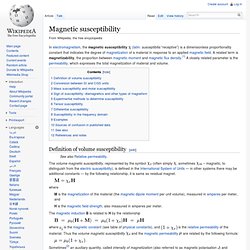
Deformation in Liquid. Ferromagnetic resonance. History[edit] Description[edit]
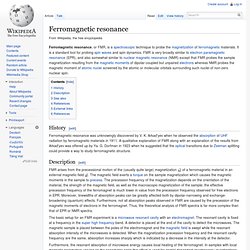
Absorption (electromagnetic radiation) An overview of electromagnetic radiation absorption.
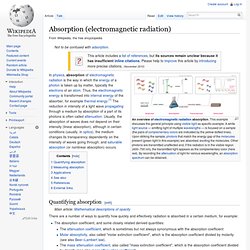
This example discusses the general principle using visible light as specific example. A white light source — emitting light of multiple wavelengths — is focused on a sample (the pairs of complementary colors are indicated by the yellow dotted lines). Upon striking the sample, photons that match the energy gap of the molecules present (green light in this example) are absorbed, exciting the molecules. Other photons are transmitted unaffected and, if the radiation is in the visible region (400–700 nm), the transmitted light appears as the complementary color (here red). By recording the attenuation of light for various wavelengths, an absorption spectrum can be obtained. In physics, absorption of electromagnetic radiation is the way in which the energy of a photon is taken up by matter, typically the electrons of an atom. All these quantities measure, at least to some extent, how well a medium absorbs radiation.
Electromagnetic absorption by water. The absorption of electromagnetic radiation by water in the gas phase occurs in three regions of the spectrum.
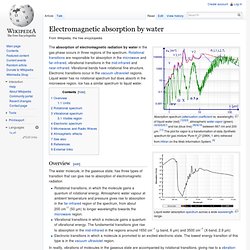
Rotational transitions are responsible for absorption in the microwave and far-infrared, vibrational transitions in the mid-infrared and near-infrared. Vibrational bands have rotational fine structure. Electronic transitions occur in the vacuum ultraviolet regions. Liquid water has no rotational spectrum but does absorb in the microwave region.
Ice has a similar spectrum to liquid water. Electromagnetic Fields (genotoxic injury) Piezoelectricity. A piezoelectric system (without contact tabs) Piezoelectricity is found in useful applications such as the production and detection of sound, generation of high voltages, electronic frequency generation, microbalances, and ultrafine focusing of optical assemblies.
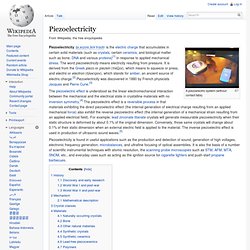
It is also the basis of a number of scientific instrumental techniques with atomic resolution, the scanning probe microscopies such as STM, AFM, MTA, SNOM, etc., and everyday uses such as acting as the ignition source for cigarette lighters and push-start propane barbecues. History[edit] Discovery and early research[edit] The pyroelectric effect, by which a material generates an electric potential in response to a temperature change, was studied by Carl Linnaeus and Franz Aepinus in the mid-18th century. A piezoelectric disk generates a voltage when deformed (change in shape is greatly exaggerated) The Curies, however, did not predict the converse piezoelectric effect.
World War I and post-war[edit] World War II and post-war[edit]